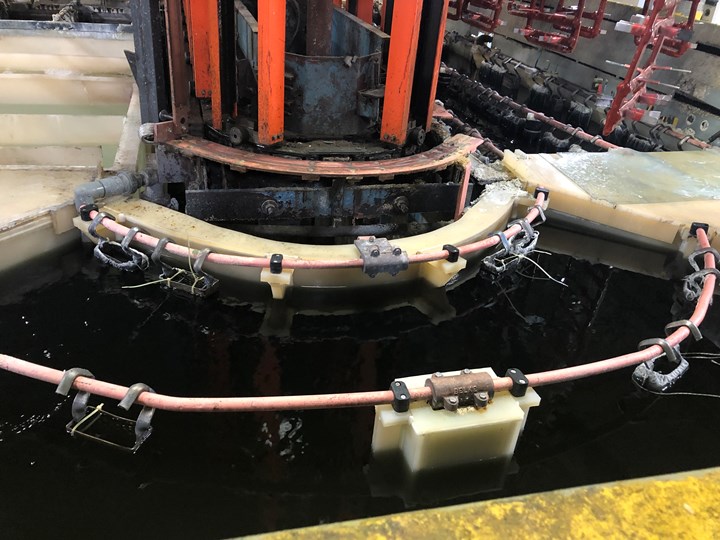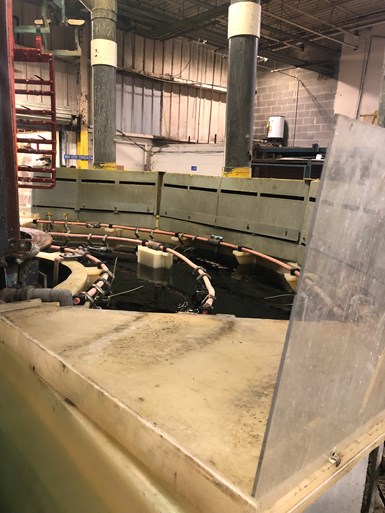
Cyanide copper strike bath
Photo Credit: MacDermid Enthone
Strike solutions are needed when plating over substrates with tenacious oxides, like stainless steels, that if not properly removed, would prevent adhesion. Substrates that are too active or porous, like zinc die-castings, also require strikes lest they become coated with a galvanic displacement (immersion) deposit. These deposits are unaided by external rectification, but rather occur when an active metal, like zinc, dissolves into an electrolyte with ions of a less active metal, like nickel, and get replaced with a non-adherent layer of that less active metal.
To overcome and surmount these aforementioned difficulties, strike solutions are designed to be intentionally low in efficiency so that the coating builds up slowly, deliberately, methodically and incrementally to ensure complete encapsulation while also washing, conditioning, activating and etching the surface of the metal via the evolution of a voluminous amount of hydrogen gas. The lower the efficiency of a solution, generally speaking, the greater the throwing and covering power or the ability of an electrolyte to deposit uniformly along the current density (CD) spectrum, (high, mid, and low CDs) and populating recessed areas with a sufficient coating.
A strike solution should be seen as a standard plating bath that has been restrained or arrested in some specific ways to reduce its inclination toward depositing without limitation. Stifling or obstructing the normal plating rate and its natural predilections or tendencies, forces the current into places it wouldn’t normally roam such as nooks, crannies, and alcoves, thus limiting plating build-up on HCD part extremities.
Cyanide Copper Strikes

Cyanide copper strike solutions are often used to coat zinc die-castings prior to a bright nickel or hex-chrome finish.
Photo Credit: MacDermid Enthone
As mentioned, zinc die-castings are notoriously difficult to plate due to zinc’s high sensitivity to both acidic and alkaline chemistries (amphoteric), high porosity, softness, and susceptibility to mechanical damage, among several other factors. Zinc die-castings are often coated in bright Watts nickel and decorative hex-chrome, but would blister if not given a strike coating of something else initially. Nickel rates relatively high on the electromotive force (EMF) series chart, as does copper, which means they are more noble (less active) than metals like cadmium, zinc, and iron. Therefore, it is preferable in a process such as this to build a layer gradually with a cyanide copper strike solution. The cyanide (CN) in this solution is kept intentionally high and the metal intentionally low in comparison to a standard cyanide copper plating bath. The cyanide acts to complex and thereby partially immobilize or handicap and inhibit the copper ions from engaging their full potential activity. Without the complexing action of the cyanide, the solution would contain a large concentration of “free” Cu ions left to interact with the substrate unimpeded and would present the potential for immersion deposition reactions and therefore adhesion failure. The CN keeps the metal sufficiently inactive so that a reaction can only proceed once a potential from the rectifier compels the ions to reduce on the cathode at the time and in the way the applicator has designed. If the metal is not kept sufficiently low and/or the cyanide is not kept adequately high to complex the available metal ions, and/or too much of the conductive ion (like caustic) is added, the bath will turn into a cyanide copper plating solution and not a striking solution.
Carbonates naturally generate in cyanide-based baths as cyanides break down after encountering carbon dioxide in the air. These carbonates can be intentionally added to a strike bath to aid in pH regulation and to lower bath efficiency, increasing deposit thickness uniformity along the CD spectrum, which is one of the primary functions of a strike solution. Strike deposit thicknesses are low at 1/5 or 1/10 of a normal plating bath’s thickness. Efficiencies are generally lower than 60% and can get as low as 10%. pH is regulated between 10-10.5 to ensure minimal attack of the substrate, which is why NaOH/KOH is limited or entirely absent from the bath. This also helps to limit any increases to conductivity. Metal is kept low to around 0.5-1.5 opg with CN:Cu ratios as high as 1-3:1. Some sources suggest a 10-30 ASF CCD for these strikes with a regular operating temperature of 120-145 F (sometimes lower).
Nickel Strikes
The highly acidic Ni strikes generate a large amount of hydrogen gas that can reduce the tenacious oxide films that stainless steels and other Ni-Cr containing base materials naturally form. There are several different Wood’s Ni strike processes and one major difference is the concentration of hydrochloric acid. Therefore, analysis for a Wood’s Ni strike solution should always require a Ni metal and a total acid test to validate optimization.
The more aggressive Wood’s formulation requires a 25% HCl solution designed for highly troublesome alloys that are not easily de-oxidized in less acidic baths. A reverse or anodic etch is conducted at 20-25 ASF for as long as 2 minutes or more and then a 5-10 minute plate at 25-50 ASF or even as high as 100-150 ASF. The high CCDs (cathode current density) are designed to ensure significant amounts of hydrogen gas is produced. Time, temperature, concentration, CCD, etching considerations and other parameters and factors will determine what process is ideally suited to the part undergoing treatment, so trial and error is required. Other Wood’s options are less aggressive and employ half the amount of HCl with no anodic etch and only a 2-4 minute plate at high current densities of 50-250 ASF.
Acidifying a standard Watts solution down to a pH of 2.0 using large amounts of sulfuric acid is an option as well. The plate time is similar to a Wood’s at 5-10 minutes and the CCD is also very high at 150-200 ASF. The compatibility of these solutions with other Watts baths makes this an attractive option for many applicators.
Sulfamate nickel strikes employ nickel sulfamate with slight variations to create two options. The sulfamic acid is used to bring the pH to below 2.0 and some utilize boric acid while others do not. CCD is high at 100 ASF+ and lower temps are used to help limit bath efficiency, which, as mentioned several times previously, acts to improve plate distribution uniformity by directing current evenly along the current density spectrum.
High pH Ni strikes or even EN (electroless nickel) strikes are sometimes needed for zincate coatings on aluminum alloys. High pH strikes use high amounts of ammonium chloride and keep the pH a full 1.0-1.5 points above normal at 5.2-5.6 to ensure dissolution or attack of the zinc in whatever form it may come, electrodeposited, immersion deposited or as a substrate, does not happen.
Conclusion
We have learned that when an electroplating solution is unsuited to plate directly onto a substrate due to the presence of oxide films or because it has low nobility (high activity), a strike bath is employed to seed a thin coating of metal onto the part and is intentionally made low in efficiency to ensure full encapsulation of geometrically-complex parts with a deposit along the full current-density spectrum. This is made possible by stifling and constraining the natural activity of a solution by choking back metal content, increasing complexants, lowering temperature, adding cathode polarizers (carbonates), increasing or decreasing pH to extreme levels, and reversing polarities (anodic etching).
Related Content
Trivalent Chrome Overview
As the finishing industry begins to move away from the use of hexavalent chromium to trivalent chromium, what factors should finishers consider as they make new investments? Mark Schario, chief technology officer for Columbia Chemical offers a helpful overview of this complicated topic.
Read More3 Tests to Ensure Parts are Clean Prior to Plating
Making sure that all of the pre-processing fluids are removed prior to plating is not as simple as it seems. Rich Held of Haviland Products outlines three tests that can help verify that your parts are clean.
Read MoreAdvantages to Pumped Eductor Agitation
Not all agitation methods are created equally. Pumped agitation with eductor nozzles can improve process tanks and quickly show a reduction in operating costs while keeping staff safe, following environmental legislation and preventing pollution.
Read MoreNanotechnology Start-up Develops Gold Plating Replacement
Ag-Nano System LLC introduces a new method of electroplating based on golden silver nanoparticles aimed at replacing gold plating used in electrical circuits.
Read MoreRead Next
Delivering Increased Benefits to Greenhouse Films
Baystar's Borstar technology is helping customers deliver better, more reliable production methods to greenhouse agriculture.
Read MoreEducation Bringing Cleaning to Machining
Debuting new speakers and cleaning technology content during this half-day workshop co-located with IMTS 2024.
Read MoreEpisode 45: An Interview with Chandler Mancuso, MacDermid Envio Solutions
Chandler Mancuso, technical director with MacDermid Envio discusses updating your wastewater treatment system and implementing materials recycling solutions to increase efficiencies, control costs and reduce environmental impact.
Read More






















